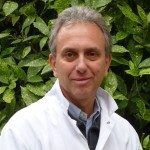Link to Pubmed [PMID] – 19008946
PLoS Pathog. 2008 Nov;4(11):e1000205
The blood-brain barrier (BBB), which forms the interface between the blood and the cerebral parenchyma, has been shown to be disrupted during retroviral-associated neuromyelopathies. Human T Lymphotropic Virus (HTLV-1) Associated Myelopathy/Tropical Spastic Paraparesis (HAM/TSP) is a slowly progressive neurodegenerative disease associated with BBB breakdown. The BBB is composed of three cell types: endothelial cells, pericytes and astrocytes. Although astrocytes have been shown to be infected by HTLV-1, until now, little was known about the susceptibility of BBB endothelial cells to HTLV-1 infection and the impact of such an infection on BBB function. We first demonstrated that human cerebral endothelial cells express the receptors for HTLV-1 (GLUT-1, Neuropilin-1 and heparan sulfate proteoglycans), both in vitro, in a human cerebral endothelial cell line, and ex vivo, on spinal cord autopsy sections from HAM/TSP and non-infected control cases. In situ hybridization revealed HTLV-1 transcripts associated with the vasculature in HAM/TSP. We were able to confirm that the endothelial cells could be productively infected in vitro by HTLV-1 and that blocking of either HSPGs, Neuropilin 1 or Glut1 inhibits this process. The expression of the tight-junction proteins within the HTLV-1 infected endothelial cells was altered. These cells were no longer able to form a functional barrier, since BBB permeability and lymphocyte passage through the monolayer of endothelial cells were increased. This work constitutes the first report of susceptibility of human cerebral endothelial cells to HTLV-1 infection, with implications for HTLV-1 passage through the BBB and subsequent deregulation of the central nervous system homeostasis. We propose that the susceptibility of cerebral endothelial cells to retroviral infection and subsequent BBB dysfunction is an important aspect of HAM/TSP pathogenesis and should be considered in the design of future therapeutics strategies.



